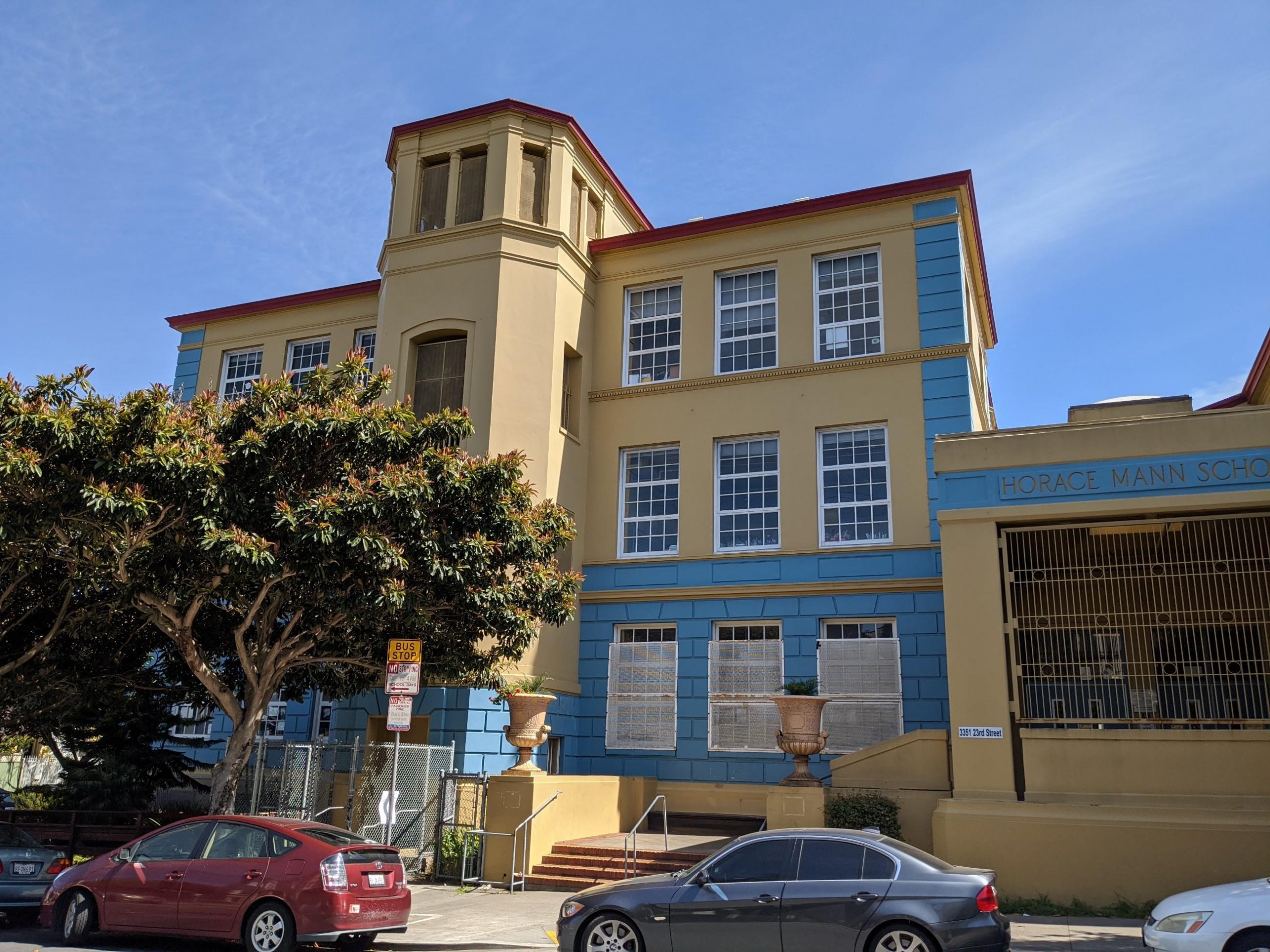When Irma Villega and Manuel Pineda lost their jobs at the beginning of the coronavirus pandemic, they were unable to pay rent and had to move out of their apartment. They stayed with family members for a month but couldn’t find new jobs or housing. With no idea where else to go, they contacted their son, Kiva’s, elementary school and asked for help.
The school’s social worker immediately connected the family with the San Francisco school district’s Stay Over program, which uses the gym at Buena Vista Horace Mann school as a temporary shelter for homeless students and their families. The social worker also helped them apply for a state-funded debit card to purchase food, and made sure that Kiva, who is in the third grade, had access to a Chromebook and his weekly homework packets.
Villega is grateful that her family has a safe space to sleep, access to three meals a day and some sense of routine for Kiva. However, she hopes to find something more stable soon. “He does his homework with the teacher online, but the problem is that he’s not comfortable here,” she said in Spanish, through a translator. “We do not have our own space and privacy. He’s always asking about when we will have a real home.”
The Villega-Pineda family may be joined in a few months by many more newly homeless families, at least one social services worker predicts. That could put even more pressure on a school district facing a budget deficit that could more than double to $86 million next year even as officials work to teach, serve and feed students and their families with schools closed during the pandemic.
“Across the schools, our social workers are hearing of many families who are going to be evicted soon and families that have been evicted,” said Laura Valdéz, Executive Director of Dolores Street Community Services, which runs the Stay Over program in collaboration with the district and the Department of Homelessness and Supportive Housing. “I think there will be a big wave of families who are going to be facing homelessness as soon as the eviction moratorium is lifted.” Mayor London Breed has issued a temporary order banning residential evictions through August 30.
“I don’t know how prepared our system is to respond to the need, but I know that we don’t want to have any families who are sheltered in the street,” she said.
The shelter normally holds up to 60 people but had to halve that number to meet social distancing guidelines. Program Manager Jacqui Portillo receives calls from new families every day looking to stay at the shelter.
The Stay Over Program has played a major role in sheltering families and helping them move to more stable situations since the shelter-in-place rules were implemented. Until March, the families would normally arrive at the shelter around 7 p.m. and leave the next morning by 7 a.m. before Buena Vista students arrived for classes. Now the shelter is open 24/7 and students staying there have full access to the playgrounds and community garden, providing a welcome respite from being stuck inside.
Daily routine for students in the shelter
Like other kids in the program, Kiva wakes up at 8 a.m. for breakfast and does homework from 10 a.m. to noon. He takes a break to eat lunch and play at the school playground until 1:30, then returns to schoolwork until 3 p.m. He might not have kids his age to play with at the shelter, but he is happy to talk to his class friends over Zoom every day, Kiva said through a translator. The family is expecting to receive packets for summer school, so Kiva’s routine will stay mostly the same over summer.
Kiva and other students are seated over six feet apart, hand sanitizer is kept at every table, staff is nearby ready to answer homework questions, and parents are asked to stay in the other room and refrain from using their phones while learning is in session.
“Everything we do is to support these kids: the food that we serve, the schedule that we have, the support that we have, the things that we ask for the community to donate,” said Portillo, the program manager.
For students experiencing homelessness, having a routine is key to maintaining some sense of normalcy. “A lot of what allows young people and children to have stability in their lives and to build resilience is being in a school setting, in a community setting, where there is something that is predictable,” said executive director Valdéz.
The Stay Over program provides students with a sense of structure and access to the school social workers to make sure the children get what they need, she said. “Many of our families, if they weren’t at our shelter, would be facing food insecurity and would have difficulty getting the resources they need from the school,” said Valdéz.
Following the city’s shelter-in-place orders issued in March, the San Francisco Unified School district has been working to adjust its curriculum to meet the needs of its students, especially those who are experiencing homelessness or who are housing insecure.
Adjusting schools to COVID-19 reality
As the school year comes to an end, the district has announced it will reopen for the fall beginning August 17. It is still workshopping how to adjust the curriculum while ensuring students and faculty are safe.
In the meantime, the district plans to continue its grab-and-go meal program, designed to help students who are food insecure, particularly those experiencing homelessness. It will also allow students to keep the Chromebooks and hotspots they were given over summer.
About 2,000 San Francisco School District students are homeless, have unstable living situations, or have to switch homes frequently. Many rely on the school for guaranteed meals during the week.
While the district regularly offers summer meals, it is normally on a much smaller scale. As more families face job loss due to COVID-19, the number of students relying on the school for meals has greatly increased. The district has served over 1 million meals to students since the first shelter-in-place order was issued in March.
The district runs 18 campus sites where parents can pick up multiple meals at once every Monday and Wednesday. Through partnerships with community organizations like the Tenderloin Neighborhood Development Corporation and the Chinatown YMCA, it operates seven extra grab-and-go sites throughout the city. It also offers door-to-door delivery for students with disabilities, dietary needs, or inability to travel. The delivery is run entirely by district employees who volunteer their time.
Students receive breakfast foods, fresh fruits and vegetables, milk, and main courses such as lasagna, enchiladas, sandwiches and chili. The district made it clear that it will feed children who are not enrolled in its schools along with the district’s 56,000 students, but adults are required to provide their child’s birthday or their school and grade when picking up food.
Besides making sure students have food, the biggest job has been getting all the students in grades 3-12 who do not have access to a computer during the day set up with Chromebooks and Internet access. Since the city’s lockdown began, the district has bought and distributed more than 16,000 devices including 13,000 Chromebooks and thousands of hotspots.
Providing mental health support
During the lockdown, the district’s wellness staffers are offering therapy not just for students, but also for their parents. Counselors and social workers like Marcus Christmas, a wellness coordinator at O’Connell High School, check in with students and their families every day.
“Many of our families are under a lot of stress right now,” said Christmas. “It’s important to remind others, teachers, students, families, to also take care of themselves and to give them techniques for how to do that. I’ll talk about how to ground yourself when you’re feeling anxious — what are some easy ways that you can calm and center yourself during this time?”
The district has also been closely collaborating with nonprofits like Compass Family Services and Hamilton Families that already have working relationships with the students.
“A lot of these nonprofits have worked in our schools and have established relationships with community members, and we’re going to use them as a resource as we muddle through this crisis,” said School Board President Mark Sanchez.
“The program manager and volunteer managers of our children’s programs are reaching out to the school districts and ensuring that every kid has a laptop, has their educational equipment to learn while in our shelter and transitional housing programs,” said Timothy Evans, chief programs officer of Hamilton Families, a nonprofit that provides shelters, education, and other resources to homeless families.
“It’s really hard for a child — even if they have access to the Internet, even if they have a device — to just sit in front of that device for hours at a time and engage with the screen and try to learn in a structured way,” said Mary Kate Bacalao of Compass Family Services. “When there are multiple family members in a single room, it’s really hard to find that space. There can be competing conversations and all kinds of things happening at once.”
Concentrating with all those distractions can be a huge challenge, she said. “We’re offering therapy support and we’re talking a lot with parents about how to support their children under those circumstances,” Bacalao added.
The key to getting through the next few months, district staff and nonprofit employees agree, is working together to provide children who are homeless with the tools they need to continue learning outside of the classroom.
Translation provided by Sasha Leon.










